
Guests
- Baynard Woodsfreelance journalist who writes for The Guardian. His recent article is titled “'Two Baltimores': DoJ investigation into police finds vast racial disparity.” He is editor-at-large for the Baltimore City Paper.
- Ralikh Hayesactivist and the coordinator of Baltimore Bloc, a grassroots collective.
A Justice Department investigation has concluded Baltimore police have carried out a practice of racially discriminatory policing by systematically stopping, searching and arresting black residents at a disproportionate rate. ”BPD engages in a pattern or practice of making unconstitutional stops, searches and arrests; using enforcement strategies that produce severe and unjustified disparities in the rates of stops searches and arrests of African-Americans; using excessive force and retaliating against people engaging in constitutionally protected expression,” said Deputy Assistant U.S. Attorney General Vanita Gupta. The 163-page report revealed “supervisors have issued explicitly discriminatory orders, such as directing a shift to arrest 'all the black hoodies' in a neighborhood.” We speak to Baltimore-based reporter Baynard Woods and activist Ralikh Hayes, the coordinator of Baltimore Bloc, a grassroots collective.
Transcript
AMY GOODMAN: A Justice Department investigation has concluded Baltimore police have carried out a practice of racially discriminatory policing by systematically stopping, searching and arresting black residents at a disproportionate rate. Deputy Assistant U.S. Attorney General Vanita Gupta outlined the findings at a news conference in Baltimore Wednesday.
VANITA GUPTA: We conclude that there is reasonable cause to believe that BPD engages in a pattern or practice of conduct that violates the Constitution and federal antidiscrimination law. BPD engages in a pattern or practice of making unconstitutional stops, searches and arrests, using enforcement strategies that produce severe and unjustified disparities in the rates of stops, searches and arrests of African Americans, using excessive force and retaliating against people engaging in constitutionally protected expression. These violations have deeply eroded the mutual trust between BPD and the community it serves, trust that is essential to effective policing as well as to officer and public safety. The problems in Baltimore didn’t happen overnight or appear in a day. The pattern or practice that we found results from long-standing systemic deficiencies in the BPD.
AMY GOODMAN: The Justice Department launched the investigation following the death of Freddie Gray, who died in 2015 of spinal injuries sustained in police custody. Although charges were brought against six police officers over Gray’s arrest and death, none has been convicted, and all remaining charges have been dropped. Deputy Assistant U.S. Attorney General Vanita Gupta outlined how African Americans are routinely targeted in Baltimore.
VANITA GUPTA: The city’s African-American residents and African-American neighborhoods bore the brunt of this activity. Out of the data we surveyed, the police department made roughly 44 percent of its stops in two small predominantly African-American districts that contain only 11 percent of the city’s population. African Americans accounted for 95 percent of the 410 individuals the police department stopped at least 10 times. Indeed, one African-American man was stopped 30 times in less than four years, with none of the stops resulting in a citation or a criminal charge.
We also found a pattern or practice of excessive force. For example, officers frequently resorted to physical force when a person did not immediately respond to verbal commands, even where the person was posing no imminent threat to the officer or others. Officers were ending up in unnecessarily violent confrontations with people in mental health—with mental health disabilities. We have seen in communities throughout the country that improved policies and enhanced training in de-escalation and dealing with people in crisis can actually enhance officer safety and reduce the need for force.
BPD also violates the First Amendment by retaliating against individuals engaged in constitutionally protected activities. Officers frequently detain and arrest members of the public for engaging in speech that officers perceive to be critical or disrespectful. And BPD officers use force against members of the public who are engaging in protected speech.
AMY GOODMAN: The 163-page report said, quote, “supervisors have issued explicitly discriminatory orders, such as directing a shift to arrest 'all the black hoodies' in a neighborhood,” unquote. The DOJ also found Baltimore police use unreasonable force against juveniles and people with mental health disabilities. Officers also show gender bias in handling sexual assault investigations.
For more, we’re joined by two guests. Baynard Woods is a freelance journalist who writes for The Guardian. His recent article is headlined “Two Baltimores: DoJ investigation into police finds vast racial disparity.” He’s editor-at-large for the Baltimore City Paper. And Ralikh Hayes, activist and coordinator of Baltimore Bloc, a grassroots collective.
We welcome you both to Democracy Now! Let’s begin with Baynard. Can you lay out these findings that the Justice Department has just released in this 163-page report?
BAYNARD WOODS: Sure. I mean, it’s really striking. On the one hand, it’s what everyone, and especially Baltimore’s black residents, have been saying. But the specificity of the data that was collected by the Department of Justice in the specific targeting of African-American neighborhoods, which goes back to the city’s segregation, that because the city is so segregated, by targeting certain neighborhoods, they’re also targeting certain populations, specifically the city’s black population. And so, you just have these vast—as we were just hearing, these vast discrepancies of more than 80 percent of all pedestrian stops are of African Americans, 95 percent of all of the stops—of all of the people stopped more than 10 times while driving. And so, you see these, and the Department of Justice is very clear in linking it back to the city’s zero-tolerance policy, which was set out to clear corners. And many of the mid-level supervisors, who were trained in that period, are still directing their officers to behave in such a way. And so that single decision or series of decisions has these wide-ranging consequences that you were just talking about.
AMY GOODMAN: Baynard, can you explain what a Terry stop is?
BAYNARD WOODS: Yes, a Terry stop is the Terry v. Ohio—comes from the Terry v. Ohio Supreme Court case. And it’s what you’re legally justified to do if you want to pat someone down. If you believe—if you have reasonable, articulable suspicion that someone has engaged in criminal activity, you can detain them for a very brief period of time in order to make sure that they aren’t armed and to investigate.
And this came up a lot in the Freddie Gray trial—in the Freddie Gray case of the trials of the officers, that it was an argument of whether he was arrested in that long period of detention or whether it was a Terry stop. And the prosecution continued to argue that, and the Department of Justice report backs it up, that it was—it exceeded the norms of a Terry stop, which should be very brief and interrogatory, and then the person is free to go.
AMY GOODMAN: And overall, why this is so significant right now, the significance of these findings, among them, talking about one individual who was stopped how many dozens of times over just a few years? Of course, African-American.
BAYNARD WOODS: Yes. So, there was a guy who was stopped 30 times over the course of the period of the investigation, and none of the stops resulted in any charges, criminal charges, or even traffic citations. And you see this through the report over and over again. Even after excessive force is used, someone will be tased or beaten, punched in the face, and then no charges are ever brought against the individual.
AMY GOODMAN: Ralikh Hayes, your group, Baltimore Bloc, released this, leaked this document. How did you get a hold of it? You were the first to put it out.
RALIKH HAYES: Sorry, I can’t actually answer that. We have to protect those that support us in the movement for liberation.
AMY GOODMAN: So, talk about what your first reaction is in reading it. Do you believe you were the first to see it?
RALIKH HAYES: I don’t think we were the first, maybe the first locally that are on the grassroots level. But I think we were probably not the first to actually have it.
So, my first reaction upon reading it was, well, water is wet, right? Like, these are things that we have been saying for a very long time in the city. We’re not even talking like the decade period in which this report covers, but decades, the entire history of the city, from when the city first began and was, you know, doing protective covenants so black people couldn’t move in certain neighborhoods. That is—this is the history of the Baltimore Police Department, the culture of the Baltimore Police Department. This didn’t just start from zero tolerance under O’Malley. This was bred into the city over decades and decades, and that culminated with zero tolerance, which pretty much gave the officers the ability to act on this culture of racism inside the Baltimore Police Department more overtly.
AMY GOODMAN: During Wednesday’s news conference, Deputy Assistant U.S. Attorney General Vanita Gupta also criticized Baltimore’s zero-tolerance policing policy.
VANITA GUPTA: But these systemic failures alone didn’t cause the problem. The police department’s zero-tolerance street enforcement strategy became a quest to produce large numbers of enforcement actions, pedestrian stops in particular, often without enough consideration of their limited impact on solving crime and their caustic damage to community relationships. With today’s city leaders—and while today’s city’s leaders have recognized these issues, many in the BPD continue to follow this strategy.
Only 3.7 percent of the police department’s more than 300,000 pedestrian stops from January 2010 to May of 2015 resulted in officers issuing a citation or making an arrest. Many of these stops and the resulting frisks lacked constitutional justification, and many of the discretionary arrests were simply street-clearing activities. Supervisors at BPD Central Booking and local prosecutors rejected over 11,000 charges made by BPD officers, because they lacked probable cause or otherwise did not merit prosecution.
AMY GOODMAN: That’s Deputy Assistant U.S. Attorney General Vanita Gupta. Ralikh Hayes, can you respond to what she said?
RALIKH HAYES: I think that is extremely accurate. I think that the Baltimore police are a gang. They’re domestic terrorists in the way they operate and occupy black communities in Baltimore City. And to—like, I know the state’s attorney was on NewsOne Now this morning trying to say, well, you know, it’s just a few bad cops. That is not the case. There is a literal culture in the Baltimore Police Department that indicts the entire system of that department, and actually policing everywhere. Right? Like, this—firing a few officers is not going to fix these issues. Changing a few policies is not going to fix these issues. Right? You can’t put a Band-Aid on a cancer wound and expect that the cancer is going to magically disappear. Right? Like, you have to remove that. Right? And so, to do that, we have to take these issues out by the root, which means there’s a culture change. There’s systemic racism in people’s minds, in the officers of Baltimore City Police Department. And we have to deal with that.
AMY GOODMAN: I wanted to ask you about the DOJ report finding that Baltimore police, as we know, disproportionately stopped African Americans, whether they’re standing, walking or driving. One chart shows the BPD officers made 520 stops for every 1,000 black residents in Baltimore, but only 180 stops for every 1,000 Caucasian residents. The report also shows African Americans are far more likely to be stopped—are far more likely to be stopped multiple times within relatively short periods of time. It reads, quote, “African-Americans accounted for 95 percent of the 410 individuals stopped at least ten times by BPD officers from 2010-2015. During this period, BPD stopped 34 African Americans at least 20 times and seven other African Americans at least 30 times.” So, Ralikh, what is Baltimore Bloc calling for?
RALIKH HAYES: We will be releasing a press statement later today. But one of the main things we want to mention about the report is that while the report verifies things that we have been saying—we and others, and black citizens, in general, have been saying for decades, it stops short of describing the trauma that this has placed on communities—right?—and the resulting—the results of that trauma. We also—you know, this also indicts Stephanie Rawlings-Blake’s leadership as mayor, because this is over her term, and the failed leadership of our elected officials, because we’ve been saying this, and they say, “Well, you know, it’s not that bad. This is not an issue.”
AMY GOODMAN: Well, Ralikh, let me go to Baltimore—
RALIKH HAYES: We’re also calling for an end—
AMY GOODMAN: Let me go to Baltimore Mayor Stephanie Rawlings-Blake, who spoke Wednesday about the DOJ’s findings.
MAYOR STEPHANIE RAWLINGS-BLAKE: The report’s assessment and its follow-up to it will help us to heal the relationship between the police and our communities. I also want to be clear that we have not been standing still while this inquiry was underway. Indeed, some of these reforms began before I asked the Department of Justice to investigate the department. The city has taken first steps in a long path to reform, and we’ve begun to see real benefits. Our police department is already making significant changes, the community is providing valuable insight, and officers and citizens are working together to improve our communities and the policing that is happening within them.
AMY GOODMAN: Ralikh, your response to what the mayor said?
RALIKH HAYES: I think she’s a liar. I think that she has no spine when it comes to actually listening to citizens and representing them. I firmly believe that, one, she’s a lame-duck mayor, and she’s going to be out of office relatively soon, so any type of commitment on her part is extremely false. I think the reforms are reforms, and they’re Band-Aid solutions. They’re not going to fix the issues, which is why Bloc is also calling for the release of all the officers’ names who were mentioned in the DOJ report of committing violations, and the firing of all those officers—and proof of their firing, because we don’t trust Commissioner Davis, either.
AMY GOODMAN: In one telling anecdote in The New York Times, they talk about a shift commander provided officers with boilerplate language on how to write up trespassing arrest reports of people found near housing projects. The template contained an automatic description of the arrestee: a black male. Ralikh?
RALIKH HAYES: I think that is the indicator of the fact that the war on drugs and zero-tolerance policing is a war on black people. Right? Like, it is specifically a war on black people and occupying black communities, as the report shows that that is not even a legal way to stop you, and clearing corners isn’t a legal way to stop people, which, for all the things I know about the legal system, I did not actually know that they could not clear corners. I’ve lived in Baltimore 23 years, and I did not know that. I thought that was a legal practice. So what does that say about the Baltimore City Police Department? What does that say about the things that happen here?
BAYNARD WOODS: And one really telling thing on that is that—
AMY GOODMAN: Baynard Woods.
BAYNARD WOODS: —the trespassing charges are so often just when someone is standing in front of a property on the sidewalk and not only—not actually on the property at all, on public space. In one case, two youths, two black youths, were arrested for loitering on their own porch. And so, what it really does come across is that the Baltimore Police Department has criminalized blackness by criminalizing public space for black people, so that being black in a public space or being—and especially them being black and transgender or black and a woman in a public space, becomes criminalized in itself.
RALIKH HAYES: And then they also further criminalize those that dissent and speak out against that, particularly organizers and activists in the community. A lot of us have been followed home, car windows broken, tires slashed. In this moment, I would uplift Tawanda Jones, sister of Tyrone West, who they have been fighting for justice for him for 159 weeks. She still gets harassed to this day. Right? Like, we’re talking over three years, and police are still harassing her.

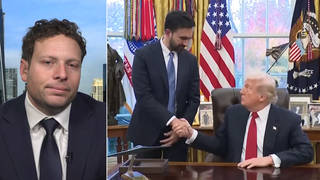
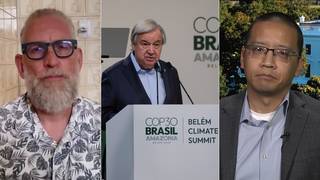
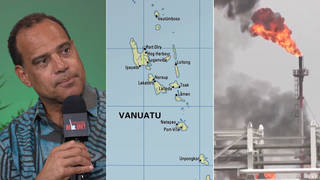
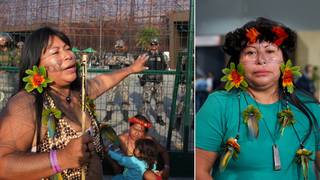





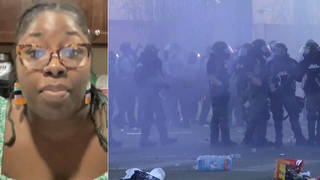
Media Options